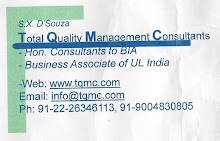HACCP and ISO 9000
The European Commission trying to improve safety of food has published two documents "Consumer Health and Food Safety" and "The General Principles of Food Law in the European Union".These papers have three general principles:
1.- The responsibility for legislation should be separate from that for scientific consultation.
2.- The responsibility for legislation should be separate from that for inspection.
3.- There should be more clarity and easier access to information throughout the decision-making process and inspection measures.
- Food chain steps
- The European Food Safety Authority (EFSA)
- What to take care of in order to ensure food safety
- History of HACCP
- Chronology of its development:
- The HACCP-concept:
- Timetable to install an HACCP System
- How to identify a CCP ?:
- X-Ray Inspection Systems
- German court undermines consumer safety and fundamental principles of HACCP
- Risks which might endanger the health of consumer
- HACCP= Hazard Analysis and Critical Control Point
- Hygiene regulations in Germany
- Hazard
- Critical Point
- Critical Control Point
- Planing HACCP
- Detailed description of every product
- Description of processing
- Static hygiene conditions:Building
- Machines and other utensils for processing of food
- Toilets
- Dynamic hygiene conditions; Cleaning, disinfection and maintenance of the building,hygienic handling of food:
- Incoming control:
- Storage and handling of raw materials
- Food prepared with raw eggs which are being pasteurised:
- Food prepared with raw eggs without heating:
- Food prepared with raw eggs without heating to be chilled consumed such as desserts:
- Production units preparing food for old or sick people and children:
- Charitable units which prepare food shortly before distribution:
- Other production units cited above:
- Production units with more than 30 meals with unheated eggs or egg components:
- Production, improve the technical processing:
- Health condition or the staff which comes in contact with food
- Pest control
- Hazard analysis of pest control
- Dissemination of pest
- Determination of critical points in relation to Pest control (CCPS)
- Factors which can facilitate pest dissemination
- Categories of effects of pest attack,according to Voigt
- General considerations about pest control
- Rodents
- Rats and mice
- Extermination of rats and mice
- Bacteria transmitted by rodents
- Viruses transmitted by rodents
- Molds transmitted by rodents
- Nematodes transmitted by rodents
- Cockroaches
- Bacteria transmitted by cockroaches.According to Hoffmann, 1985
- Viruses transmitted by cockroaches. According to Hoffmann, 1985
- Yeast and molds transmitted by cockroaches. According to Hoffmann, 1985
- Protozoa and nematodes transmitted by cockroaches. According to Hoffmann, 1985
- Flies
- Bluebottle
- Bacteria transmitted by flies. According to Hoffmann 1985,Steinbrink 1989
- Bird control
- Fumigation, Methyl bromide
- Canadian IPM without methyl bromide [107]
- HACCP for supermarkets
- How to install an HACCP system for supermarkets
- Total Quality Management
- Hyperlinked Management
- Introduction of the Hyperlinked Management
- Hyperlinked Management Structure
- Software to handle Global Hyperlinked Management
- HACCP and small businesses
- Regional Programmes for Food Security (RPFS)
- Multilateral trade negotiations on agriculture
- ISO 15161:2001, Guidelines on the application of ISO 9001:2000 for the food and drink industry
- ISO 22000: 200x Food Safety Management Standard
- Overview of the BRC/IoP Standard
- Content of the BRC/IoP Standard
- Certification bodies
- EN45011: The standard for the European Accreditation of bodies who are involved in certification
- Detail of the Standards
- Auditing Standard ISO 19011
- Quality Control
- Deming's Management-Program
- Arman Feigenbaum
- Interoperability of Standards
- The main producers of national standards
- International Standards
- International Organization for Standardisation
- ISO 9001:2000
- Specifications
- Control of non-conforming products
- Economics of Quality
- Pork quality and pH
- EMAS
- ISO 14001
- European food safety regulation activities in EU
- EC General Food Law Regulation 178/2002 [69]
- Shelf life testing












No comments:
Post a Comment